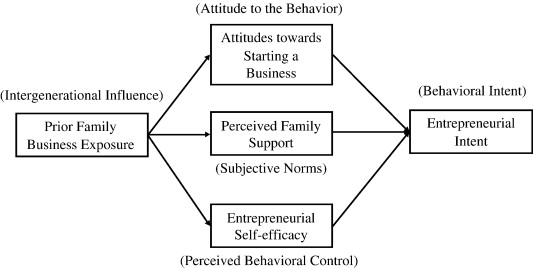Introduction
Conflicts and family go hand in hand, and it is quite obvious that the conflict within a family will only affect the family member or certain individuals in the family. But family business conflicts are subject to face tremendous difficulties. The characteristics of a family business could be identified as straightforwardness to entering, intricate to deal with and complicated to exit. The anecdotal evidence and empirical research have manifested that most of the time conflict in the family business would arise out of interpersonal disagreement and desire for power (Bhasin, 2021). The impact of conflicts within the family businesses could have been identified by slowing down of business activities and also barriers to growth at the same time.

The purpose of this reflective report is to develop and manifest a scenario, through which the attributes of a family business conflict could be painted. The aim of this reflective report is to focus on the provided case study and identify the sources of the conflicts in the family business. It also aims at evaluating then different theories of conflict that can be aligned with the situation and recommendations could also be developed depending on that theoretical explanation at the same time. The suggestions would be evident in turning whatever negative situation arising from the case study into positive forces or outcomes.
Background
With reference to the case study provided in the appendix, the main conflict has been identified as the conflict revolving around the authority and power of the business. After the sudden demise of the father, both sisters got involved in the conflict and both have their separate points of view.
Son’s point of view:
According to the son, the authority and the power of business should be given to him as he is the only male heir of the family and business. It is also observed that the sob had feared that the family business and its heredity might go to his sister’s present family which is also a matter of concern (Davis & Collette, 2021).
Daughter’s point of view:
The daughter’s concern in this regard is identified with the fact that due to her higher qualification and greater management skills than her brother, she believes that she is worthy of having the authority and power to run the business. Apart from this, the daughter also fears losing inheritance in the course of business and the property. Along with this, the social discriminating perspective is also there as she has been married to another family, and it is not her right to claim the authority of the business as well (Harland, 2021).
Another conflict:
Another conflict that has been identified in terms of the father’s brother taking over the business on a temporary basis as both the heirs are indulged in a conflict. Here, another significant conflict is that the brother and the sister might not get their right and authority later in future as the uncle might not get ready to give up the authority of the business and the power as well (Levinson, 2021).
Theories of conflict and its application in the family business:
Conflicts in the family business have become an inevitable idea and concept that has the power to influence the business and its outcomes as well. The typical family business conflict can be identified through the idea of jealousy and desire for power. The case study has manifested how the inner conflict could create tension in the business scenario. Though it is also observed that there are many issues involved in the course of creating conflicts in the family business and in relation to the case study, conflict revolving around ownership can be observed. The ownership conflict is between the two siblings over the matter of company ownership (Davis & Collette, 2021). Apart from this, the conflict can also be observed in the context of a succession of the family business as the daughter has been married and carrying the name of another family. Therefore, the theories related to the conflict in the family business are to be discussed here to understand the factors working behind the conflicts.

Agency theory:
The agency theory in the context of a family business can be identified as an appropriate theory which follows the systematic framework and involves certain principles to deliver a better opportunity for the conflicts to be resolved. On the other hand, the agency theory is something that is applied in the course of the family business when the interrelated concerns are being investigated. The agency theory is being applied to understanding the concerns and the factors behind conflicts in a family business (Binz Astrachan et al. 2021). Here, the alignment of agency theory in the course of the conflict in family business could be identified as the main contribution where the behavioural patterns and the financial improvisations could be suggested.
Resource-based theory:
The resource-based theory generally refers to the idea of strategic management in terms of ensuring competitive advantages and financial frameworks. In the course of the case study, the resource-based theory could be aligned by concentrating on the role it plays during the conflicts and concerns. On the other hand, as the resource-based theory relates to the resources that can be utilized to gain a competitive advantage, this could be aligned with the ongoing conflicts of the case study (Colli et al. 2013). Due to the conflicts, the resources of the organization and its performance could get influenced and the direct impact the competitive advantages as well.
Other theories:
Along with the above-mentioned two theories, it could be stated that social capital theory and the organizational identity theory could also be discussed in this regard. The social capital theory is something that enables the family businesses to identify and utilize the resources inherited within the family and the family relationships based on the cognitive and social developments that could be utilized to increase productivity (Le Breton-Miller et al. 2015). Therefore, the organizational identity theory refers to the identification of the family members as important organizational assets. Therefore, with reference to these theories, the sources of conflicts in the given case study could be identified to understand the connection between the scenarios.
Sources of conflict:
The conflict in family business certainly stems out of factors or a few sources. There are certain sources of conflicts that can be observed in the given case study. Therefore, the sources of conflicts are stated as below;
- Decisions that the head of the business would take for the future course of strategic management are likely to cause severe conflicts among the family members and internal stakeholders.
- The performance and active participation of the family members in the business are also considered as one of the main sources of conflicts as in this regard the sense of favouritism works behind.
- The remuneration or the extent of authority given to the family members could also cause conflicts in the family business as this could create an extent of confusion regarding their responsibility, power and authority in the business (Qiu & Freel, 2019).
- Most importantly, the individual who would hold the higher position in the business could create conflict if not stated in a clear manner as shown in the case study.
- The external sources or demand of power could also be another source such as the uncle’s temporary dominance over the business could lead to internal family conflicts and source of conflict in business performance as well.
- Along with this, other sources of conflict are,
- Favouritism
- Feeling of acknowledgement
- Succession
- Ownership
- Confusion regarding family and business roles
In relation to the identified sources of conflicts, the conflict theory can be discussed in this regard and analyzed to understand how it related to the given situation. The conflict theory specifically concentrates on the conflicting areas and argues the reasons and factors that can create conflicts (Mihic et al. 2015). In accordance with the situation given, it could be stated that the sources of conflicts can be related with the help of arguments placed to extract relevant solutions to the identified issues. Therefore, the below recommendations can be considered in terms of turning the situation into a positive one and resolving the concerns at the same time.
Recommendation for the family business conflicts to be resolved:
Regarding the case study, the family business conflict is highlighted subject here, and I have realised that conflict is the form of disagreement between the family members and their various perspectives towards the business are one of the main reasons. As the family business belongs to almost all the members of a family, therefore, providing authority to a single person would be a matter of conflict in an evident manner. Apart from this, as the father did not pass on his authority of business to other of his children there would be a possible conflict between the siblings regarding the authority and control of the business as well. On the other hand, unresolved disagreements are also a great contributor to the course of generating conflicts.
Family business conflicts eventually impact the growth and sustainability of the business negatively while the succession and ownership remain under question as well. Along with this, I have also realised that the ownership and succession conflicts could be the main reason that 70% of the family businesses are failing to perpetuate (Roberts, 2021). Therefore, it is very much important that the reason and core of the issue must be identified which leads to the conflicts arising. On the other hand, the case study has also compelled me to understand that not only power but there are other reasons also exist through which conflicts could arise. Therefore, the resolution of the conflicts is important to be delivered and cited in this regard so that I would be able to provide a clear insight into how the issues could have been managed.
Recommendation:
- Primarily, it was the responsibility of the father to understand the situation and foresee the conflicts as the ability to foresee things is the ultimate key to a successful business. On the other hand, preparing a will prior to any situation could be another important thing to do. Most importantly, it was the father’s duty to clarify the roles and responsibilities that both of his children would be carrying out even in his absence (Mihic et al. 2015). In this manner, the conflicts between the authorities and the owner could have been avoided as well.
- Another significant task that should have been attended was to bring the important people under one roof and discuss the responsibilities, for example, both the children should have been explained about the business situation and asked to give their opinion so that a sense of understanding between the two could be formed.
- Third, the important task was to consider the means by which the conflicts and individual differences could have been resolved with discussion and understanding of the differentiated point of view (Mihic et al. 2015).
- Reconciliation of the difference of opinion and understanding of the difference of perspectives could have been resolved by explaining the complexity of business management and also by concentrating on family unity as well.
- Preparing a board of directors and a committee who would be partial in making decisions and could focus on the best interest of businesses while making the decisions as well. In this manner, the conflicts could have been resolved by making the family members participate and discuss the skills that could lead the business to grow in future as well.
- Both the children could work in a collaborative manner, in order to overpower and take back the authority of the organisation and business from their uncle.
- Apart from this, both the children could learn from each other and implement in terms of increasing the organisational productivity and creating value for the business as well (Rautiainen et al. 2012).
- Most importantly, leveraging formal governance structure to mitigate the conflict so that legal conflicts among family members could be prevented.
Conclusion
To conclude, the above-stated strategies and tasks could have saved the father and his family business from getting into conflict and it is also realised that many family conflicts have boiled down to ages as the conflicts have not been resolved with systematic intervention and solutions as well. In my belief, the roles and responsibilities of the management should have been divided among the children and a single successor or ownership should have been out of the context as well. Therefore, the reflective report has provided a clear overview of what the family business conflict is and how it could occur in the course of a business scenario. On the other hand, my opinion of the case study is that the above-mentioned ideas and practices could have saved the business and other family businesses from being devastated and ruined. If the systematic order of communication could have been followed, then the family businesses are subjected to have a prosperous and stable growth in future.
References
Bhasin, S. (2021). Conflict and the Families in Business. The Economic Times. Retrieved 19 March 2021, from https://economictimes.indiatimes.com/familybusinessforum/insights/conflict-and-the-families-in-business/articleshow/61740140.cms?from=mdr.
Binz Astrachan, C., Astrachan, J., Kotlar, J., & Michiels, A. (2021). Addressing the theory-practice divide in family business research: The case of shareholder agreements. Journal Of Family Business Strategy, 100395. https://doi.org/10.1016/j.jfbs.2020.100395
Colli, A., Howorth, C., & Rose, M. (2013). Long-term perspectives on family business. Business History, 55(6), 841-854. https://doi.org/10.1080/00076791.2012.744589
Davis, J., & Collette, C. (2021). Understanding Conflict in the Family Business | CFEG. CFEG Main. Retrieved 19 March 2021, from https://cfeg.com/insights_research/understanding-conflict-in-the-family-business/.
Harland, D. (2021). 5 ways to manage conflict in a family business. Intheblack.com. Retrieved 19 March 2021, from https://www.intheblack.com/articles/2015/10/28/5-ways-to-manage-conflict-in-a-family-business#:~:text=Formal%20structures%20like%20family%20councils,business%20from%20its%20management%20functions.
Le Breton-Miller, I., Miller, D., & Bares, F. (2015). Governance and entrepreneurship in family firms: Agency, behavioral agency and resource-based comparisons. Journal Of Family Business Strategy, 6(1), 58-62. https://doi.org/10.1016/j.jfbs.2014.10.002
Levinson, H. (2021). Conflicts That Plague Family Businesses. Harvard Business Review. Retrieved 19 March 2021, from https://hbr.org/1971/03/conflicts-that-plague-family-businesses.
Mihic, M., Arsic, S., & Arsic, M. (2015). Impacts of entrepreneurs’ stress and family members on SMEs’ business success in Serbian family-owned firms. Journal Of East European Management Studies, 20(4), 452-483. https://doi.org/10.5771/0949-6181-2015-4-452
Qiu, H., & Freel, M. (2019). Managing Family-Related Conflicts in Family Businesses: A Review and Research Agenda. Family Business Review, 33(1), 90-113. https://doi.org/10.1177/0894486519893223
Rautiainen, M., Pihkala, T., & Ikävalko, M. (2012). Family Business System Models – A Case Study and Some Implications of Open Systems Perspective. Journal Of Small Business & Entrepreneurship, 25(2), 155-168. https://doi.org/10.1080/08276331.2012.10593566
Roberts, M. (2021). Managing the Family Business: Entrepreneurs Needed for Long-Run Success. HBS Working Knowledge. Retrieved 19 March 2021, from https://hbswk.hbs.edu/item/managing-the-family-business-entrepreneurs-needed-for-long-run-success.
Appendix
Case study:
“Unitech real estate services are a family business that runs for the past 45 years, under the name of Mr Andrew Smith. The business has been dealing with real estate services all around the UK and it’s a family-running business that has been able to service more than 1500 customers in the last 10 years. Mr Smith has two children one daughter and one son and both of them are inherently associated with the business wholeheartedly. Following an unfortunate illness, Mr Smith has passed away without appointing an heir to the business. Now, it has become a matter of conflict between the siblings as the son of Mr Smith named Harlow, demands power over the organisation justifying that he is the male heir of the family. On the contrary, the daughter Emilia is married to another family which is being highlighted by the son as a barrier to holding a higher position for her in the company. Therefore, an inner family conflict rises up while the brother of Mr Smith named Mr Edward took upon the control for running the business.”
